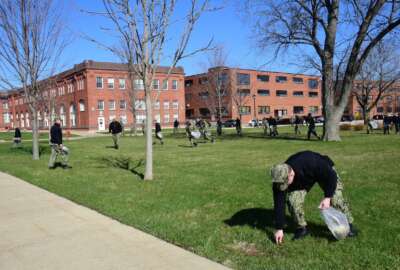

Army camps and bases often feature architecture worth preserving. One example is Camp Dodge, an Army National Guard training facility in Iowa. Its construction and...
Army camps and bases often feature architecture worth preserving. One example is Camp Dodge, an Army National Guard training facility in Iowa. Its construction and facilities management staff won a Pentagon award earlier this year for restoration of its 1907 gate house and perimeter fence. For more details, Federal Drive with Tom Temin spoke with Col. John Perkins, the Facilities and Management Director at Camp Dodge.
Interview Transcript:
Tom Temin And just tell us about Camp Dodge itself. There’s some significance of it historically and to the state of Iowa.
John Perkins Camp Dodge is the only military facility in the state of Iowa. It Is actually a state military facility currently. It was established in 1907. Our first building actually went in in 1909. In World War I, we were the 13th national cantonment to help build up the forces for World War I. It went back to the state and we were getting federalized in 1942. And then after World War II, we’ve been a state facility ever since.
Tom Temin And where exactly in the state is it?
John Perkins So Camp Dodge is just north of Des Moines, which is right in the center part of the state.
Tom Temin Got it. So there’s Des Moines on one side and cornfields around the other three sides.
John Perkins Well, yes, it is Iowa. Yes.
Tom Temin All right. Yeah, well, they make good corn out there. And you are the facilities director, but you’re National Guard, so you’ve got kind of two hats, right? Civilian and military?
John Perkins That’s correct. So I’m a dual status military technician. So GS-14 day-to-day. I’m also a colonel in the Army National Guard. And as with all federal technicians who are in the National Guard, our regulation requires us to wear the uniform, so we’re pretty indistinguishable.
Tom Temin All right. Understood. And what happens there and how large is the place? How many people come and go every day? What’s that? Give us a sense of.
John Perkins So Camp Dodge has about 5000 acres. So it’s not a large from a training standpoint, but we’re between the third and fifth busiest post as far as the National Guard post and the National Guard inventory. We regularly train between 350,000 to 400,000 soldiers a year. We have several activities here, such as the National Maintenance Training Center, a center that does some combat simulation on the computers. And so there’s a lot of soldiers that come through here, as well as Marines, Army Reserve, most of your reserve component in Iowa, because we have the only ranges in Iowa also. As well as we also help train some civilians such as – or they use our ranges such as law enforcement and police.
Tom Temin Got it. And so there are quite a number of buildings and facilities you have to look after, then.
John Perkins Yeah. So on Camp Dodge are about 375 facilities on Camp Dodge alone.
Tom Temin Golly. And some of them go back, you say, is the 1909 building still there?
John Perkins Yes. Yes, 1909 building is there. It was actually a powder house. It was constructed by tile with all non-Spartan surfaces. So it goes back to that time frame. But the fence actually does date from 1937, so.
Tom Temin Okay. So this project we’re talking about that won an award. The award was for what? Sustainment and for what?
John Perkins Yeah, it was. It was a restoration and preservation of a cultural artifact. So we have both an environmental heritage we’re very proud of here at Camp Dodge. We have a lot of species on Camp Dodge we take care of. We also have a lot of cultural artifacts. So in this particular case, this fence was built as part of the CCC, the Work Progress Administration. Civilian Conservation Corps in 1937. So these were people that did not have jobs, they brought them in. It was all done by hand labor. They learn a skill, learned a craft, and we thought it was worth preserving. It is not on the national historical register per se, but it is historical register eligible. And what’s very important to me is a lot of those young men that came did this work, they later served in World War II. So we’re talking about an artifact of the greatest generation.
Tom Temin And the fence has 99 pillars. And these are not just wooden posts, are they?
John Perkins No, No, they’re not. So each pillar is about three feet by three feet square, about four feet tall. And they are made of Indiana limestone. About an inch to two inch thick pieces. And they’re laid in there and mortared in place. So 100% of it was hand work. To include the foundation, the foundation of the pillars were not poured in concrete, we discovered during the restoration. They’re actually bigger pieces of limestone all cemented by hand.
Tom Temin Interesting. So some real craftsmanship there. We’re speaking with Col. John Perkins. He’s director of construction and facilities management for the Iowa National Guard. And then in addition to restoring those pillars, you also had a gatehouse.
John Perkins Yeah. So the gatehouse was part of it. Very interesting. It has some hand forged iron elements into it. It replaced a former gatehouse there off of what used to be the main entrance to Camp Dodge and very looks almost like castle style. But again, it was those young men back in ’37 putting it all together.
Tom Temin And what was the state of it when you decided to restore it?
John Perkins So it was solid. Some pillars had been hit by cars that had gone off the road over the years. There was cracking, there was grass growing up in there, rocks had split out it, mortar had fallen out of it. And really it was really a decision of letting such a cultural resource go, or putting a little bit of money back into it to preserve it for the next generation.
Tom Temin And what did it take to do the restoration?
John Perkins From a standpoint of work, they literally had to go back and do handiwork. They had to cut out the stones, grind out mortar, replace stones, interiors that, recement things using mortar that was the same color, cement on top of the same color to cap it. And then it was cleaned in an environmentally safe manner with a pH-neutral power wash and replace some of the wood elements on it restored like new.
Tom Temin Wow. And this is true of the gatehouse also.
John Perkins That’s correct.
Tom Temin And were concrete foundations put under the pillars or did you just simply restore the bases that were there from the thirties?
John Perkins We restored the bases over there, so in a large part we dug down where we had to, but really it was, it needed to be repaired, but the stone mortar, it lasts a long time is really pretty solid. Just those elements had to be redone.
Tom Temin Yeah, like your own pyramids right there on Camp Dodge.
John Perkins After this restoration, they will outlast me.
Tom Temin And who did the work?
John Perkins It was a company, I can’t remember the name, unfortunately, out of Wisconsin, they did this restoration work. A local architectural engineering firm named Snyder Associates did this. And it’s very gratifying to us because the company came in and they hired a lot of local labor and taught some skills. When they put this back in there. And again, it was very much a labor intensive process.
Tom Temin Sure. And how did you pay for it?
John Perkins So this was a combination of federal funds and state funds to do this, which is pretty common, a National Guard post to have that mixture of funds.
Tom Temin So there is federal money, meaning that the Pentagon at some point ultimately feels that this type of activity to preserve these heritage sites is worth it.
John Perkins Yeah, it is, because it does represent our post. If you go through a military facility, whether it’s a Fort Leavenworth, you’ll see some history preserved. Now, that being said, we do have to make some hard decisions on whether we maintain a building, whether it’s culturally relevant is one factor, whether it’s architecturally relevant or it’s really worth restoring. We have had some cases where we’ve had some World War II buildings that were temporary, World War II buildings that we just tore down some last year, that they’re neither architecturally relevant and they had just exceeded their lifespan. So we want to spend our money frugally, but there are worthwhile to preserve some things.
Tom Temin Yeah, it’s like the Navy annex in Washington. I think it was supposed to be torn down in the fifties and it lasted up until about the eighties till they finally remove those buildings. I guess they were historic in the minds of the people that had worked there, but as structures, they weren’t terribly significant.
John Perkins And as a National Guard base, as a member of our community, what I found is during this restoration, this has hit the community newspapers. I received a lot of comments, community people stop me. So it’s also an icon of the community. So we have to be as a federal member of a community, we have to be very, very aware of that also.
Tom Temin Yes, because you said that sometimes a car has hit the stone pillars over the years, which means there’s a community and roads and traffic going by Camp Dodge. So the people maybe locally have adopted it.
John Perkins That is correct. We have great relationship with our community and we consider ourselves a part of the community and as well as an asset.
Tom Temin And what’s next on your list to possibly restore and refresh?
John Perkins So we’re finishing up a multi-, multi-year restoration of one of the only two existing World War II induction hospitals left in the United States. While we’re restoring of the outside to look what it look like with the appropriate windows and appropriate roofing. However, inside are the most modern classrooms to train our soldiers and airmen that you’ve ever seen. So we believe we can accomplish both. Maintain that readiness, reuse a structure without having to build a new one, which is good for the environment also, but preserve the heritage on the outside.
Tom Temin Do you have any really nice cannons or some old maybe Army Air Corps aircraft there too?
John Perkins Absolutely. If you look up the news, we just flew back an F-86. Well, we a Chinook helicopter picked it up off Carthage, flew to a paint facility in the Air National Guard in Sioux City and just delivered it back on post and it’s now back on display at all its glory.
Copyright © 2025 Federal News Network. All rights reserved. This website is not intended for users located within the European Economic Area.
Tom Temin is host of the Federal Drive and has been providing insight on federal technology and management issues for more than 30 years.
Follow @tteminWFED


